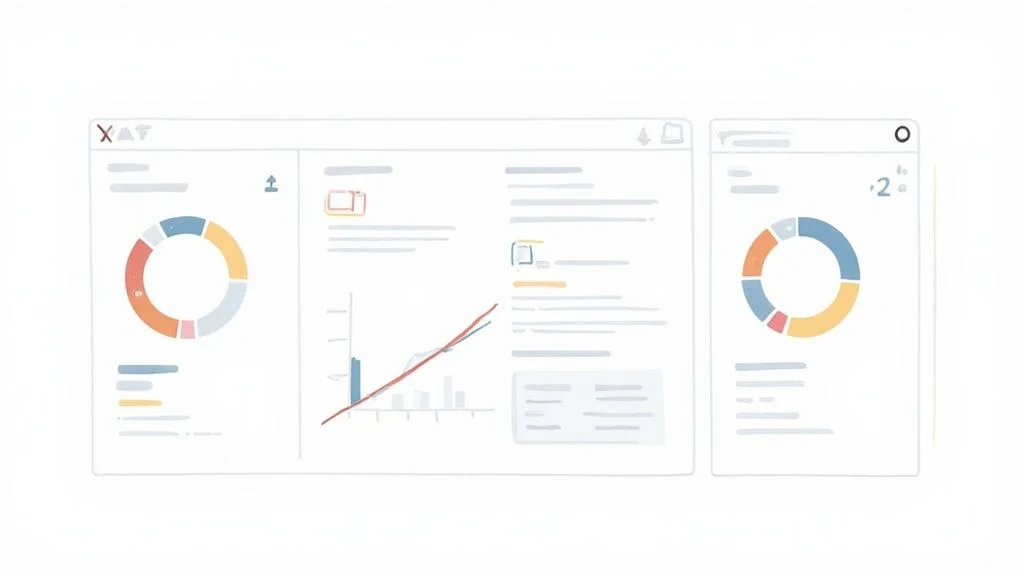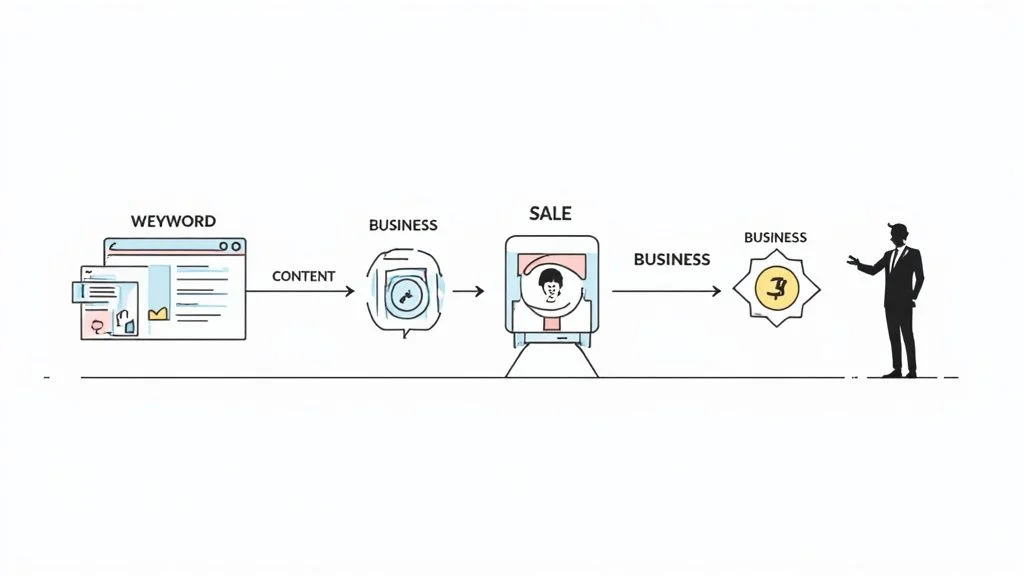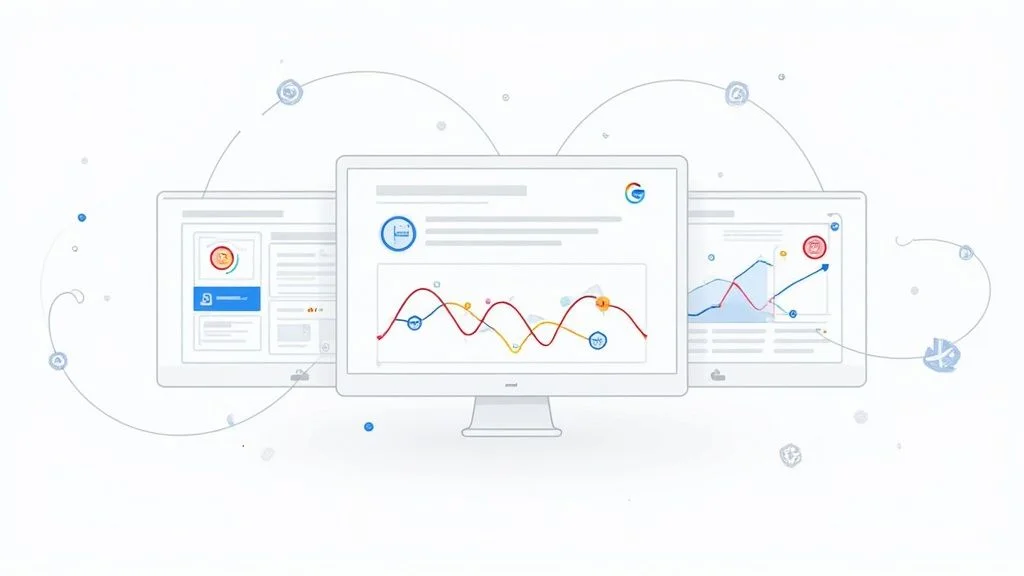
How to Measure SEO A Practical Guide
Sections
Let’s be honest: measuring SEO success today is a completely different ballgame. It’s time to move past the old-school obsession with vanity metrics like raw traffic numbers and keyword rankings. The real goal is to track business-oriented outcomes.
We need to be asking tougher questions. Are we driving organic conversions? How are users actually engaging with our site? What’s our true visibility, beyond a few top-ranking keywords? This is how you find out if the right people are finding you - and if they’re taking the action you want them to take.
#Why Old SEO Metrics No Longer Tell the Full Story
If your entire SEO report boils down to “organic traffic is up” and “we’re on page one for X keyword,” you’re missing the bigger picture. It’s just not enough anymore.
The way people use search engines has changed dramatically. We’re living in an age of complex user journeys, zero-click searches, and AI-powered results. This new reality demands a much smarter, more sophisticated measurement strategy.
#The Problem with Vanity Metrics
Vanity metrics - think total organic sessions or a #1 ranking for one specific keyword - look great on a PowerPoint slide, but they often have a weak connection to actual business goals.
So you got a huge spike in traffic? That’s great, but it’s meaningless if it’s from an irrelevant audience that bounces off your site in seconds. Likewise, ranking number one for a keyword nobody is searching for isn’t going to drive a single dollar of revenue.
The core issue here is that these metrics lack context. They tell you what happened, but they almost never tell you why it happened or what business impact it had. True SEO measurement is about drawing a clear line from your activities to tangible results like leads, sales, and customer lifetime value.
For example, a dashboard like this one from Google Analytics is a good starting point. It shows user acquisition, which is useful information.

But this is just the surface. The real insights come when you dig deeper to see which channels are actually driving conversions, not just clicks.
#Adapting to the New Search Landscape
The search engine results page (SERP) is no longer a simple list of ten blue links. It’s a dynamic, interactive space filled with featured snippets, “People Also Ask” boxes, and now, AI Overviews that answer questions directly within Google.
This has led to a massive increase in what we call “zero-click searches” - where a user gets their answer without ever clicking through to a website.
The scale of this is staggering. In 2025, it’s estimated that Google will process over 190,000 searches every second. That’s a huge jump from 81,000 per second in 2020. This shows just how much organic visibility matters, but it also means our old friend, the click-through rate (CTR), is becoming less reliable as a measure of true SEO value.
This shift means that visibility and brand presence within the SERP itself are now incredibly valuable assets. Metrics that capture this, like impression share and share of voice, are becoming absolutely essential. They help you understand how often your brand shows up for important queries, even if those appearances don’t result in a click.
Our guide to digital marketing performance metrics dives deeper into how you can start integrating these newer KPIs into your reporting. A successful measurement strategy has to account for this new reality, focusing on what genuinely moves the needle for the business.
#Key SEO Metrics At a Glance
To get started, it helps to have a clear map of what to track, what it means, and where to find the data. This table breaks down the core metrics you should have on your radar.
| Metric | What It Measures | Primary Tool |
|---|---|---|
| **Organic Traffic** | The number of visitors coming from search engines. | Google Analytics |
| **Keyword Rankings** | Your website's position in SERPs for target keywords. | Ahrefs, Semrush, GSC |
| **Click-Through Rate (CTR)** | The percentage of impressions that result in a click. | Google Search Console |
| **Backlinks** | The number and quality of links from other websites. | Ahrefs, Moz, Semrush |
| **Organic Conversions** | The number of goal completions from organic visitors. | Google Analytics |
| **Impressions** | How often your pages appear in search results. | Google Search Console |
| **Bounce Rate** | The percentage of visitors who leave after viewing one page. | Google Analytics |
While no single metric tells the whole story, tracking these together gives you a much more holistic view of your SEO performance and its direct impact on your business objectives.
#Building Your SEO Measurement Framework

Tracking every single metric you can get your hands on is a classic recipe for analysis paralysis. It’s easy to get lost in a sea of data. Instead, the real goal is to build a focused measurement framework that speaks directly to what your business actually cares about.
This is how you start translating SEO activities into the language of the C-suite - revenue, qualified leads, and tangible growth. It all starts by asking one simple question: “What does success really look like for us?” The answer will be completely different for every business, but it’s the critical first step in connecting your SEO key performance indicators (KPIs) to outcomes that truly matter.
#Align SEO KPIs with Business Goals
The first thing you need to do is draw a straight line from your organic search efforts to your company’s bottom line. This means shifting your mindset away from just “ranking higher” and toward “driving qualified business outcomes.” This alignment is the absolute foundation of any meaningful SEO measurement strategy.
Take a B2B SaaS company, for example. Their primary goal isn’t just traffic; it’s about generating high-quality leads that the sales team can actually close. So, their SEO framework should be built to reflect that.
-
Primary SEO KPI: Marketing Qualified Leads (MQLs) from organic search.
-
Secondary Metrics: Demo request submissions, whitepaper downloads from organic visitors, and rankings for high-intent, “solution-aware” keywords.
Now, contrast that with an e-commerce brand. They are laser-focused on transactions, so their framework will look completely different.
-
Primary SEO KPI: Revenue from organic search.
-
Secondary Metrics: Organic conversion rate, average order value (AOV) from organic customers, and visibility for specific product category keywords.
This strategic alignment is non-negotiable. When you can confidently say, “Our content optimization project in Q2 led to a 15% increase in organic MQLs,” you’re demonstrating real business impact, not just vanity metrics.
#Create a Personalized Dashboard
Once you know exactly which KPIs matter, the next move is to build a dashboard that gives you clarity, not clutter. Think of this dashboard as your command center, offering a real-time view of what’s working and what isn’t. It needs to be designed to answer your most important questions at a glance, allowing you to be proactive.
A solid SEO measurement framework depends heavily on accurate data and reports that are tailored to your goals. You can get a great overview by checking out a step-by-step guide to GA4 reporting and custom reports to learn how to visualize the data that matters most. This ensures you’re not just collecting data but turning it into actionable intelligence.
For a publisher or a media site, the game is all about engagement and ad revenue. Their dashboard might highlight things like:
-
Average session duration from organic visitors to see if the content is engaging.
-
Pages per session to understand how well they’re keeping users on the site.
-
Ad impressions or revenue per thousand sessions (RPM) specifically from the organic channel.
#From Data to Decisions
When you have a well-built framework, measurement stops being a reactive reporting chore and becomes a proactive strategic tool. Instead of just documenting what happened last month, you can use your data to guide what you do next.
See a sudden drop in organic conversions for a key product page? Your framework should immediately trigger an investigation. Is it a technical glitch? Did a competitor just leapfrog you in the SERPs? Or has user intent for that keyword fundamentally shifted? This is how you move from just knowing how to measure SEO to using those measurements to drive constant improvement.
Ultimately, your framework should empower you to tell a compelling story about your SEO performance. To learn more about putting this narrative together, check out our guide on how to create SEO reports that stakeholders will actually read. This is how you shift the conversation from abstract metrics to tangible business results.
#Your Essential Toolkit for Tracking SEO Performance
Having a solid framework is one thing, but you need the right tools to bring it to life. Knowing how to measure SEO performance means getting your hands dirty with real data. This isn’t about collecting a dozen different software subscriptions; it’s about building an integrated workflow that connects the dots between visibility, user behavior, and actual business goals.
We’ll start with the free, foundational tools from Google and then layer in a third-party platform to paint a complete picture. Think of this as your core SEO measurement stack.

This dashboard is your direct line to how Google sees your site. It offers unfiltered data on impressions, clicks, and average position for the queries that matter most.
#Start with Google Search Console: The Source of Truth
Google Search Console (GSC) is non-negotiable. It’s the single most accurate source of information about how your site performs in Google’s search results because the data comes directly from the source. It tells you exactly what people searched for when they saw your site, how often they saw it (impressions), and how often they clicked (CTR).
You might find you’re getting thousands of impressions for a keyword you aren’t even actively targeting. That’s a golden opportunity. That high impression count tells you Google already sees you as relevant for that topic. Your next move is to create or optimize content to better match that search intent and turn those impressions into clicks.
GSC is your ground zero for understanding true search visibility. To really get the most out of it, check out our guide on how to use Google Search Console to uncover these hidden keyword opportunities.
#Connect to Google Analytics 4 for User Behavior
While GSC tells you what happens before someone clicks, Google Analytics 4 (GA4) tells you what happens after they land on your site. This is where you connect search performance to genuine user engagement and business outcomes.
Imagine GSC shows a page is getting tons of clicks for “eco-friendly packaging solutions.” That’s great, but what happens next? GA4 can show you:
-
How long those users actually stayed on the page (average engagement time).
-
Whether they bounced immediately or explored other pages.
-
Most importantly, if they completed a key action, like filling out a contact form (conversions).
If GSC shows high traffic but GA4 shows low engagement and zero conversions, you don’t have a traffic problem - you have a content or user experience problem. This connection is vital for diagnosing performance issues accurately.
#Layer in Third-Party Tools for Competitive Insights
Google’s tools are fantastic for analyzing your own site, but they won’t tell you much about your competitors. This is where platforms like Ahrefs or Semrush come in. They provide the competitive context you need to understand where you really stand in the market.
These tools are essential for things like:
-
Backlink Analysis: See who is linking to your competitors and find opportunities to build your own authority.
-
Keyword Gap Analysis: Uncover valuable keywords your competitors are ranking for that you’re completely missing.
-
Share of Voice: Estimate your visibility for a set of target keywords compared to your main rivals.
By weaving these three types of tools together, you create a powerful workflow. GSC identifies the opportunity, GA4 measures the on-site outcome, and a tool like Ahrefs benchmarks your progress against the competition.
#Comparing Core SEO Measurement Tools
To make it even clearer, here’s a quick breakdown of how these tools fit together. Each has a specific job, and they work best when used in tandem.
| Tool | Primary Focus | Key Metrics to Track | Best For |
|---|---|---|---|
| **Google Search Console** | Pre-click SERP performance | Impressions, Clicks, CTR, Average Position, Queries | Understanding organic visibility and finding keyword opportunities direct from Google. |
| **Google Analytics 4** | Post-click on-site behavior | Users, Sessions, Engagement Rate, Conversions, Bounce Rate | Measuring what users do after they arrive and connecting traffic to business goals. |
| **Third-Party SEO Tools** | Competitive & market analysis | Backlinks, Keyword Rankings, Share of Voice, Competitor Traffic | Benchmarking against competitors, analyzing backlink profiles, and market research. |
Ultimately, this integrated approach ensures you’re not just tracking isolated metrics but building a comprehensive understanding of your entire SEO performance.
#How to Measure Content Performance and Authority
Effective content does way more than just pull in traffic. Think of it as the engine that builds your website’s authority and, more importantly, actually contributes to your business goals. If you want to prove the real ROI of your content marketing, you have to look past simple page views and focus on the metrics that signal trust, authority, and genuine engagement.
We’re going to move past those surface-level numbers and dig into the good stuff: backlink velocity, leads generated per article, and how your topic clusters are performing. It’s all about finding your “workhorse” content - the pieces that keep delivering value long after you hit publish - and spotting the articles that are falling flat and need a refresh.
#Beyond Page Views: Identifying Content Workhorses
Let’s be real: not all content is created equal. Some articles might bring in a steady stream of traffic but generate zero leads. Others might get less traffic but attract high-quality backlinks that lift your entire site. Learning how to measure content’s SEO impact means knowing the difference.
A great place to start is with backlink velocity. This is simply the rate at which a specific piece of content is earning new backlinks. A high velocity is a fantastic sign that other sites see your content as valuable and authoritative, which is a powerful signal to Google.
Another game-changer is tracking leads generated per article. By setting up proper conversion tracking in a tool like Google Analytics, you can connect the dots between form fills, demo requests, or downloads and the exact blog posts that brought them there. This tells you exactly which topics are hitting home with your audience and pushing them to act.
#The Power of High-Authority Backlinks
I once worked with a client where we published a massive, long-form guide. At first, the team was pretty disappointed. Direct conversions from that page were almost non-existent, and they started to question its value. But when we dug a little deeper, a totally different story emerged.
Over the next six months, that one guide earned over a dozen high-authority backlinks from major industry publications and even a few university websites. It became the go-to resource in their niche. While it wasn’t converting visitors directly, the authority it passed to the rest of the site was incredible. We saw a clear lift in rankings for an entire product category, which led to a huge jump in qualified leads.
This is a classic example of why measuring content needs a wider lens. The value wasn’t in the immediate conversion but in the long-term authority and trust it built, creating a ripple effect across the whole domain.
A dashboard from a tool like Ahrefs is perfect for keeping an eye on your referring domains and new backlinks over time.
Watching this growth helps you pinpoint which content pieces are your most valuable link-building assets.
#Using Data to Inform Your Content Strategy
Your analytics are also a goldmine for finding content that’s losing momentum. These are your prime candidates for a content refresh. Hop into Google Search Console and look for pages that used to rank well but have started to slip. Often, a simple update - adding new stats, refreshing the information, or improving the on-page SEO - is all it takes to bring them roaring back to life.
As algorithms and user habits change, one thing remains constant: in-depth, high-quality content wins. We consistently see that content pieces over 3,000 words get three times more organic traffic than shorter articles. These bigger guides also tend to earn four times more shares and 3.5 times more backlinks, which shows just how much depth and expertise align with Google’s E-E-A-T framework.
Ultimately, whether for SEO or other goals, a key part of your framework has to involve robust strategies for measuring content performance to truly understand what’s working. By checking in on these metrics regularly, you can make smart, data-driven decisions to refine your content calendar, double down on topics that drive results, and continuously build your site’s authority.
#Measuring Your SEO Impact Beyond Google Search

If you really want to master SEO measurement, you have to look beyond the classic Google search bar. A customer’s journey to find you is almost never a straight line, and it often starts on platforms you might be completely ignoring in your reporting. To get the full picture of your organic visibility, you need to expand your measurement strategy to the places where your customers are actually asking questions.
This means looking at platforms that are powerful search engines in their own right. For a lot of businesses, this boils down to two key areas: local search via Google Business Profile and visual search on platforms like YouTube. Ignoring these is like leaving huge sections of your map blank - you’re missing critical touchpoints where potential customers are actively looking for what you offer.
The truth is, search is diversifying. While Google still dominates with an estimated 91.52% of the global search market, other platforms are carving out significant chunks of user intent. And with a projected 92.3% of global internet users on mobile devices in 2025, app-based and local search metrics aren’t just nice-to-haves anymore. The takeaway is simple: your measurement has to be as multi-channel as your audience.
#Capitalize on Local Search with Google Business Profile
For any business with a physical storefront or a defined service area, your Google Business Profile (GBP) is a goldmine of performance data. The insights here aren’t just about website clicks; they measure real-world interactions that often lead directly to revenue.
Think about it. When a potential customer finds you on Google Maps or in the local pack, their next action tells you exactly what they want. Your GBP dashboard reveals it all:
-
Direction Requests: This isn’t just a click; it’s a person trying to physically get to your location. It’s the clearest indicator of foot traffic driven by your local SEO.
-
Phone Calls: Tracking calls straight from your profile shows you how many people were motivated enough by your listing to connect immediately.
-
Website Clicks: This measures the traffic flowing from your GBP to your site, giving you a clean line of sight between your local visibility and your online hub.
I once worked with a local restaurant convinced their SEO was failing because website traffic was flat. A quick peek into their GBP insights told a different story: a 40% increase in direction requests and a 25% jump in phone calls month-over-month. The SEO was working; it was just driving offline business that their traditional analytics were completely missing.
#Uncover Search Intent on YouTube
Don’t make the mistake of thinking YouTube is just a video-sharing site. It’s the second-largest search engine on the planet. People flock to it for “how-to” guides, product reviews, and visual deep dives. If video is part of your content strategy, measuring your performance here is non-negotiable.
Head over to YouTube Analytics and click on the “Reach” tab. The Traffic source types report is where the magic happens. Look for “YouTube search.” This is your main KPI for video SEO.
A high percentage of views from search means your videos are successfully ranking for relevant queries and grabbing user intent. You aren’t just getting lucky with the recommendation algorithm; you’re actively answering questions. Digging into the specific queries driving those views will give you powerful insights into what your audience wants to learn, helping you shape your entire content calendar.
#Got Questions About Measuring SEO?
Diving into SEO data can sometimes feel like you’ve opened a can of worms. Even with a solid plan and the right tools, tricky situations pop up all the time. This section is here to give you clear, straightforward answers to the most common challenges you’ll face when you start measuring your SEO performance seriously.
We’ll tackle the practical hurdles that can trip you up, from setting realistic goals to explaining why your numbers don’t always match up. Think of this as your guide to navigating the gray areas of SEO reporting with a bit more confidence.
#How Often Should I Be Reporting on SEO Performance?
This is one of the first questions everyone asks, and the honest answer is: it depends entirely on who you’re talking to and what you’re trying to show. There isn’t a single correct schedule, but you can - and should - tailor it to the audience.
For your own team or your personal analysis, a weekly check-in is a great habit. It helps you spot trends, catch technical hiccups before they become disasters, and make quick adjustments. It’s all about staying proactive.
When it comes to clients or the C-suite, though, monthly reporting is usually the sweet spot. SEO is a long game, and weekly ups and downs can cause unnecessary panic. A monthly report gives you enough data to show meaningful progress and tell a coherent story about your strategy’s impact.
Here’s a simple breakdown I like to follow:
-
Weekly Check-ins: This is for the core SEO team. You’re focusing on tactical stuff like ranking changes for new content, indexing status, and any sudden traffic shifts you see in Google Search Console.
-
Monthly Performance Reviews: Perfect for clients or department heads. Here, you highlight the key trends in organic traffic, conversions, and keyword visibility. Crucially, you need to connect these metrics back to the business goals.
-
Quarterly Strategy Meetings: This one’s for the executives. It’s the big-picture view. Focus on ROI, growth in organic leads, your share of voice against competitors, and how SEO is actually contributing to the company’s bottom line.
Remember, the point of a report isn’t just to dump data on someone’s desk. It’s to provide insights that lead to smarter decisions. Always adjust the frequency and depth to match what your audience actually cares about.
#Why Does My GSC Data Never Match My GA4 Data?
Ah, the classic head-scratcher. You log into Google Search Console (GSC) and see 1,000 clicks, but Google Analytics 4 (GA4) is only showing 850 organic sessions for the same time frame. It feels like something’s broken, but it’s usually just two different tools measuring two very different things.
GSC measures what happens on Google’s turf - the search results page. A “click” is counted the very instant a user clicks your link in the SERP.
GA4, on the other hand, measures what happens on your website. A “session” only kicks off after the user’s browser successfully loads your GA4 tracking code.
A lot can happen between that GSC click and the GA4 session starting:
-
The user clicks your link but slams the “back” button before your page fully loads. GSC counts the click, but GA4 never gets the signal.
-
A user might have JavaScript turned off in their browser, which stops the GA4 script from running at all.
-
Your site could be slow to load, causing impatient users to bail before the analytics tag even has a chance to fire.
A good way to think about it is that GSC measures the intent to visit, while GA4 measures the actual visit. That gap between the two numbers is often a valuable diagnostic tool. A big discrepancy could be a red flag for technical issues like slow page speed or problems with your tracking setup.
#How Do I Set Realistic SEO Growth Expectations?
This is so important. Setting realistic expectations is the key to maintaining trust with clients and stakeholders. Promising a #1 ranking for a super-competitive keyword in 30 days is just setting yourself up for failure. Real SEO success is about steady, sustainable growth, not overnight miracles.
Before you set any goals, start with a baseline audit. You can’t chart a course if you don’t know where you’re starting from. Analyze your current organic traffic, your keyword rankings for core topics, and your backlink profile. It’s also a great idea to use a third-party tool to see how you stack up against your top three competitors.
Your growth potential really boils down to a few key things:
-
Your Website’s Authority: A brand-new site is going to grow much, much slower than an established domain with years of history and a healthy backlink profile.
-
The Competitiveness of Your Niche: Trying to rank for “best credit cards” is a completely different ballgame than ranking for “local bakery in a small town.”
-
Your Resources: How much high-quality content can you create? What resources do you have for technical fixes and link building? The answers directly impact your timeline.
Instead of promising specific ranking positions, frame your goals around tangible metrics you can actually influence. For example, a realistic six-month goal for a newer site might be: “Increase organic traffic by 50% by targeting long-tail keywords and publishing eight high-quality blog posts per month.” It’s specific, it’s measurable, and it’s grounded in the actions you’ll be taking.
Ready to stop guessing and start making data-driven decisions? Rankdigger connects directly to your Google Search Console data to uncover your best opportunities for growth. Take control of your SEO strategy and see real results. Explore Rankdigger today.

